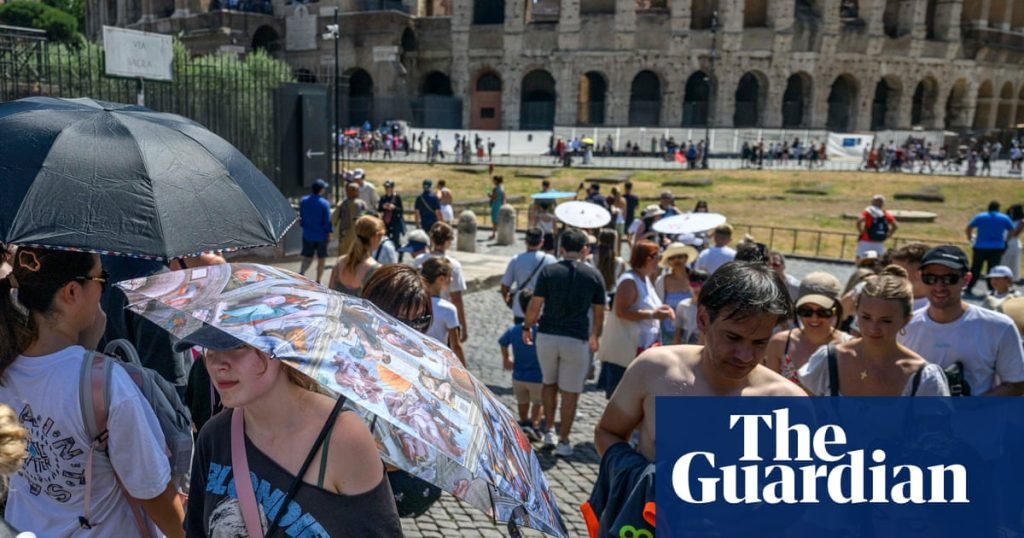The EU should slash its planet-heating pollution by 90% by 2040, the European Commission has announced, in a proposed change to its climate law that falls short of what its scientists have advised.
The much-awaited target to cut emissions, which is measured against pollution levels from 1990, is a significant milestone on the EU’s path to decarbonise its economy by 2050.
Green groups, however, are furious that it leaves room to count foreign carbon credits, such as planting trees and saving forests, that researchers have often found are ineffective.
The announcement of the legally binding target, which comes as much of the continent swelters in a scorching days-long heatwave, had been delayed by months after pushback from member states that found the headline figure of 90% too ambitious.
Wopke Hoekstra, the EU climate commissioner, said the discussion around the target had been “politically sensitive” but defended measures introduced to win over national capitals.
The new approach to reaching the target allows the use of domestic carbon removals through the EU’s emissions trading system and offers more flexibility across different sectors of the economy. It also opens the door for limited use of carbon offsets from 2036.
Critics, including scientists, have raised fears of junk offsets that are impossible to verify or that claim carbon savings for projects that may have gone ahead anyway, a concept known as “additionality”.
“If we don’t manage to do it in a way that is verifiable, certifiable and additional, then you could raise questions on whether it is actually effective,” Hoekstra said. “But humanity has done more difficult things than this, and I am absolutely convinced that we will pull it off.”
The European Scientific Advisory Board on Climate Change had recommended the commission aim for slightly steeper cuts of 90-95%. It emphasised it should achieve them through “domestic action”, which would exclude the use of carbon offsets.
The advisers said such a level of ambition was feasible and would increase the fairness of the EU’s contribution to global climate action.
Mohammed Chahim, a Dutch lawmaker and climate lead for the centre-left Progressive Alliance of Socialists and Democrats (S&D) grouping, said the proposals were little more than window dressing and raised questions about climate justice. “Europe risks shirking its responsibilities – polluting at home while planting trees abroad to buy a clean conscience,” he said.
An EU official defended the proposal, saying the use of international credits was “politically pragmatic and economically rational”. The target would allow carbon credits to make a 3% contribution to emission reductions, in line with Germany’s position, and would be allowed only in the second half of the next decade.
The official said they would “strongly advise” against buying credits in the current voluntary carbon market, but new carbon trading rules finalised at the Cop29 climate conference in Baku last year provided a very different context. “Still, a lot of work is needed to get all this right,” they added.
The planet’s most important stories. Get all the week’s environment news – the good, the bad and the essential
Privacy Notice: Newsletters may contain info about charities, online ads, and content funded by outside parties. For more information see our Privacy Policy. We use Google reCaptcha to protect our website and the Google Privacy Policy and Terms of Service apply.
after newsletter promotion
The target would need to be agreed by member states and passed by the EU parliament before being translated into a target for 2035 under UN climate treaties. The EU has to submit a new climate action plan before Cop30 in Brazil in November.
Teresa Ribera, the EU’s green transition chief, pointed to forces feeding climate scepticism, polarisation and delay to explain the extra flexibility that some member states had asked for. “The world at the beginning of 2024 is not the world of today,” she said. “We still had a huge majority – including one of the biggest countries – supporting multilateralism. This is not the case any more.”
The target comes amid a broader rollback of environment policy in the EU, which campaigners say is gaining momentum. The deregulation drive has shocked observers with its scale and speed.
Some industry groups were also dismayed by the proposal. The European federation of industrial energy consumers (IFIEC) said it supported the goal of climate neutrality by 2050 but found the proposed 90% target “a disproportionate and unrealistic” acceleration of the ambition.
“An overly steep reduction curve ignores this reality and runs the risk of accelerating de-industrialisation in Europe and massively importing CO2 emissions,” said Hans Grünfeld, president of IFIEC.
Green groups said the target fell short of the EU’s responsibilities as one of the world’s biggest historical emitters of greenhouse gases. “The European Commission will try to portray this as an ambitious step forward, but the reality is we are fast running out of room to achieve the Paris agreement,” said Colin Roche, climate justice and energy coordinator at Friends of the Earth Europe. “This target is in line neither with climate science nor with climate justice.”
Thomas Gelin, a campaigner at Greenpeace EU, said the EU had a historical responsibility to cut emissions at home. “The EU’s 2040 climate targets should drive a shift away from fossil fuels, starting with an EU ban on new fossil fuel projects, towards renewables and energy saving, to cut people’s energy bills, make their homes easier to heat and cool, and clean the air they breathe,” he said. “Instead, the European Commission relies on dodgy accounting and offshore carbon laundering to pretend to hit the lower bound of what its climate scientists advise.”

